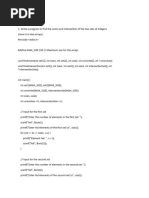Radix Code (Data Structures)
Uploaded by
Abdul Moiz FarooqRadix Code (Data Structures)
Uploaded by
Abdul Moiz Farooqpackage main;
import java.util.LinkedList;
import java.util.Queue;
/**
* Implementation of radix sort.
*
* @author Anton Gustafsson
*
*/
public class Radix {
public static void main(String[] args) {
new Radix();
}
/**
* Array with numbers to be sorted.
*/
public Radix() {
int[] unsorted1 = { 9, 179, 139, 38, 10, 5, 36 };
int[] unsorted2 = { 667342, 1745359, 556139, 343538, 5510, 45, 5536 };
radixSort(unsorted1);
}
/**
* Performs radix sort, a kind of bucket sort. From right to left, take the
* least significant number and put them in their corresponding bucket. Then
* take them out, and that value is now sorted. Then do it again for all
* valules, ex first "ones", then "tens" and so on.
*
* @param unsorted
*/
public void radixSort(int[] unsorted) {
// Create a box with 10 buckets.
Queue[] box = new Queue[10];
for (int i = 0; i < box.length; i++) {
box[i] = new LinkedList<Integer>();
}
System.out.print("Unsorted list: ");
printArray(unsorted);
// Find the longest number in the unsorted array.
int length = 0;
for (int i = 0; i < unsorted.length; i++) {
int n = (int) (Math.log10(unsorted[i]) + 1);
if (n > length) {
length = n;
}
}
int m = 10; // The number to use modulo on
int n = 1; // The number for rounding division.
// Repeats as long as the highest number in the array.
for (int i = 0; i < length; i++) {
// Perform calculation and put element in correct bucket.
for (int y = 0; y < unsorted.length; y++) {
int nbr = (unsorted[y] % m) / n;
box[nbr].add(unsorted[y]);
}
// Now remove the numbers in order and put them in a new array.
int x = 0;
for (int j = 0; j < box.length; j++) {
while (!box[j].isEmpty()) {
unsorted[x] = (int) box[j].remove();
x++;
}
}
System.out.print("Partly Sorted " + n + "'s: (");
printArray(unsorted);
m *= 10;
n *= 10;
}
System.out.print("Sorting complete: ");
printArray(unsorted);
}
/**
* Prints the given arrays elements.
*
* @param arr
*/
private void printArray(int[] arr) {
for (int i = 0; i < arr.length; i++) {
System.out.print(arr[i] + ", ");
}
System.out.println(")");
}
}
You might also like
- Analytics Mania Getting Started With Google Analytics 4100% (1)Analytics Mania Getting Started With Google Analytics 481 pages
- Case Study On Amazon Simpledb For A Particular Real-World ApplicationNo ratings yetCase Study On Amazon Simpledb For A Particular Real-World Application7 pages
- Write a Java program that first sorts an integer array using bubble sort an_20241230_223135_0000No ratings yetWrite a Java program that first sorts an integer array using bubble sort an_20241230_223135_000023 pages
- Q7) Write A C++ Program Using Types of Sorting.: 1. Bubble Sort 2. Insertion SortNo ratings yetQ7) Write A C++ Program Using Types of Sorting.: 1. Bubble Sort 2. Insertion Sort19 pages
- Accord Info Matrix: Programming QuestionsNo ratings yetAccord Info Matrix: Programming Questions19 pages
- Class Static Void Int: Program (Printarry ( (,) Arr)No ratings yetClass Static Void Int: Program (Printarry ( (,) Arr)2 pages
- Name - Lokesh Banthia Class - Xi A Roll Number - 10No ratings yetName - Lokesh Banthia Class - Xi A Roll Number - 1016 pages
- 8a0f296f-65a1-4e75-b584-cb789a3299d0 (3)No ratings yet8a0f296f-65a1-4e75-b584-cb789a3299d0 (3)35 pages
- Assignment No 1: Ayub Khan As Presidentof PakistanNo ratings yetAssignment No 1: Ayub Khan As Presidentof Pakistan3 pages
- Software Architecture and Design: Architectural Description Language ADLNo ratings yetSoftware Architecture and Design: Architectural Description Language ADL16 pages
- Bosch Video Management System - Configuration Manual100% (1)Bosch Video Management System - Configuration Manual260 pages
- 9. Thiết Kế Đồ Án Công Nghệ Chế Tạo MáyNo ratings yet9. Thiết Kế Đồ Án Công Nghệ Chế Tạo Máy190 pages
- C V D P: Omputer Iruses Estructive RogramsNo ratings yetC V D P: Omputer Iruses Estructive Rograms3 pages
- Candidate Application Form - Suparjono - Gis and Survey PDFNo ratings yetCandidate Application Form - Suparjono - Gis and Survey PDF5 pages
- Service Interface User Guide, February 2022 DOCA0170EN-02No ratings yetService Interface User Guide, February 2022 DOCA0170EN-0264 pages
- Genie™ 2000 Spectroscopy Software: OperationsNo ratings yetGenie™ 2000 Spectroscopy Software: Operations387 pages
- Pisi Bethania Titalessy DJJ Uoibis Jog Flight - OriginatingNo ratings yetPisi Bethania Titalessy DJJ Uoibis Jog Flight - Originating2 pages
- An Overview of Remote Access VPNS: Architecture and Efficient InstallationNo ratings yetAn Overview of Remote Access VPNS: Architecture and Efficient Installation10 pages
- WDT 8 6 Operation Guide Slides (For SBC) - V2 1 - 2No ratings yetWDT 8 6 Operation Guide Slides (For SBC) - V2 1 - 231 pages
- PM0085-B Brochure, OPTI CCA-TS2, English (Web)No ratings yetPM0085-B Brochure, OPTI CCA-TS2, English (Web)4 pages





























































































